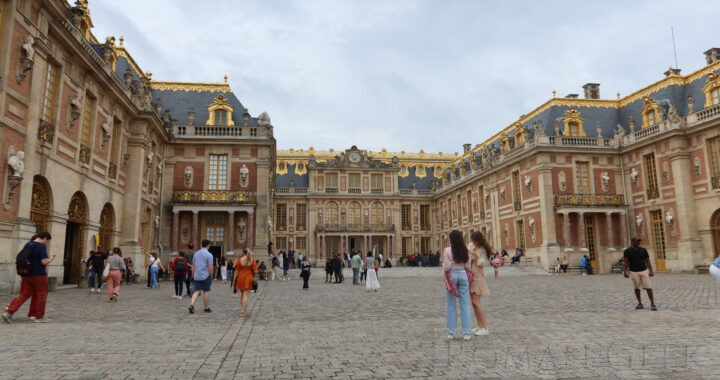- The Palace of Versailles and its Park and Gardens is an enormous palace and museum in France built by Louis XIV between 1661-1715.
- It is located 10 miles (17km) west of Paris and is a UNESCO World Heritage Site.
History
- The Palace started out as a Royal Hunting Lodge in 1623, but was turned into a Palace by Louis XIV. Construction took place between 1661-1715.
- In 1682 Louis XIV moved the Court and Government from the Louvre Palace in Paris to the new Palace and accommodated the Nobility and Officials in the newly built city of Versailles.
- Versailles effectively replaced Paris as the centre of French Government and Louis XIV resided there until his death in 1715.
- The Palace with its Gardens and Fountains have had a major influence on architecture in Europe and during the next century, ten Palaces were built in the style of the Palace of Versailles.
Architecture
- The chief architect between 1661-1670 was Louis le Vau, who had previously designed the Chateau de Vaux-le-Vicomte. He developed the style known as French Classicism, also known as the ‘Style Louis XIV’, which he merged with the Baroque style of architecture.
- The Gardens were designed by Andre le Notre and reflect the style of the French Formal Garden.
- The Palace of Versailles is shaped in a U facing east. The Dufour Pavilion in the south and the Gabriel Pavilion in the north create the Royal Court in the centre. Two large symmetrical wings flank the Royal Court.
- The main floor contains the State Apartments, Hall of Mirrors, the Hall of Battles, the Royal Chapel and the Royal Opera.
- There are 2,300 rooms, 2,143 windows, 1,252 chimneys and 67 staircases.
- A pumping station was built on the river Seine at Marly-le-Roi in 1681 to bring water to Versailles.
Connection with Ancient Rome
- Between 1686 and 1708, Louis XIV (1638-1715) directed the French Consul in Tripoli, Claude Lemaire, to send 600 columns from Leptis Magna and ship them to France in order to build the Palace of Versailles and other Palaces in Paris.
Musee de l’Histoire de France (Museum of French History)
- The museum was opened in 1837 by King Louis Philippe I to reflect the history of France under the Monarchy, Napoleon and afterwards.
- The collection includes over 6,000 paintings and 3,000 sculptures, some of which are on display in the rooms and galleries in the North Wing and South Wing of the Palace.
- Galerie des Batailles, 1st floor, South Wing:
- 36 large historical paintings and 82 statues of military figures.
- Salles des Croisades, Ground floor, North Wing:
- Five rooms with paintings depicting the Crusades.
- Salle de 1792, 1st floor, South Wing:
- Paintings depicting the French Revolution.
- Consulate and Empire Rooms, Ground floor, South Wing:
- Paintings depicting Napoleon and his military campaigns.
- Salle de 1830, 1st floor, South Wing:
- Paintings depicting the July Revolution.
- Galleries of Africa, Crimea and Italy, 1st floor, North Wing:
- Paintings depicting Louis Philippe’s campaigns.
- Galeries de pierre, four corridors on the Ground floor and 1st floor in the North and South Wings:
- Sculptures of French historical figures.
- Galerie des Batailles, 1st floor, South Wing:
Palace of Versailles

